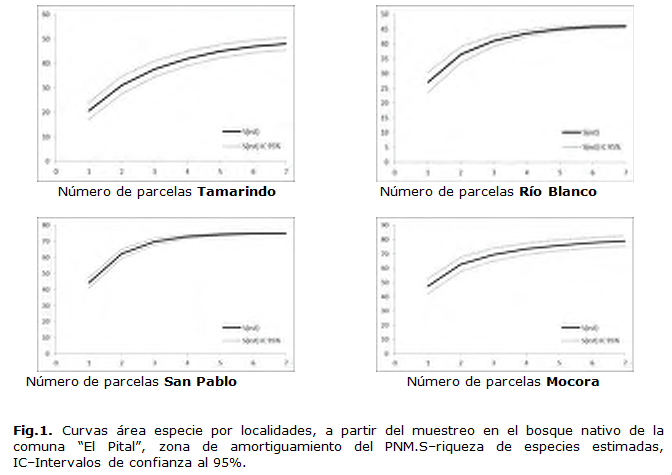Flora and vegetation arborea characteristic of the communal El Pital, National Park Machalilla, Ecuador
Main Article Content
Abstract
With the objective of characterizing the composition and structure of the forest formations of the Commune, Pital, Zone of Damping of the Machalilla National Park and to elaborate guidelines of actions of ecological restoration for its conservation was carried out the structural characterization of four localities of the dry forest Equatorial forest belonging to two plant formations, the tropical spiny mount and the premontane spiny mount ranging from 40 to 460 masl. For the investigation, 28 temporary sampling plots of 50 x 20 m (0.10 ha) were established, the tree species ≥ 10 cm of DAP were measured. A total of 1,346 individuals represented in 89 species belonging to 82 genera and 42 families were identified and evaluated. The localities were compared statistically in terms of wealth, composition, structure and diversity. High alpha and beta diversity were found; Height above sea level, basal area and density are the variables that most influence the segregation of four types of forests that differ in their composition and forest structure. Significant, promising and rare species were identified, with the most important species being Cordia alliodora, Nectandra acutifolia and Ficus velutina. The family with the most species and genera is Fabaceae. Most individuals (58%) were recorded in the 10-20 cm diameter class for all four locations. Based on the results obtained, initiatives for sustainable forest management are projected through the application of methods for ecological restoration and conservation of these tropical forests.
Downloads
Article Details
References
AGUIRRE, M. Z. LINARES-PALOMINO, R. KVIST, L. Especies leñosas y formaciones vegetales en los bosques estacionalmente secos del Ecuador y Perú. Arnaldoa [En línea]. 2006, 13 (2). 324 -350. ISSN: 1815-8242. Disponible en: https://www.researchgate.net/profile/Reynaldo_Linares-Palomino/publication/262103256_Especies_lenosas_y_formaciones_vegetales_en_los_bosques_estacionalmente_secos_de_Ecuador_y_Peru/links/0deec536d94044adc6000000.pdf
ANGIOSPERM PHYLOGENY GROUP (APG III). An update of the Angiosperm Phylogeny Group classification for the orders and families of flowering plants: APG III. Botanical Journal of the Linnean Society [En línea]. 2009, abril, 141(4). 399-436. DOI: 10.1046/j.1095-8339.2003.t01-1-00158.x. Disponible en: http://onlinelibrary.wiley.com/doi/10.1046/j.1095-8339.2003.t01-1-00158.x/full
BREHM, G. et al. Mountain rain forests in southern Ecuador as a hotspot of biodiversity – limited knowledge and diverging patterns. En E. Beck, J. et al. (Eds.) Gradients in a tropical mountain ecosystem of Ecuador.. Heidelberg: Ecological Studies. 2008, p. 15-25. ISBN 978-3540-73525-0
CANTOS, C. G. Impactos antrópicos sobre el bosque nativo de la comunidad El Pital, Zona de amortiguamiento del Parque Nacional “Machalilla”, Doctoral dissertation, Tesis de maestría inédita. Universidad de Pinar del Río Hnos. Saíz Montes de Oca, Pinar del Río, Cuba, 2012.
CANTOS, C. G. 2014. Caracterización estructural y propuesta de restauración del bosque nativo de la comuna El Pital, zona de amortiguamiento del Parque Nacional Machalilla, Ecuador”. Tesis doctoral, Pinar del Río: Universidad de Pinar del Río, 2014. Disponible en: http://repositorio.educacionsuperior.gob.ec/handle/28000/1691
CANTOS, C. G. Y GARCÍA, L. Estudios dendrológicoa de las principales especies maderables del bosque del Parque Nacional Machalilla. Tesis de pregrado, Ecuador: Universidad Técnica de Manabí, 1991
CERÓN, C. E. y MONTALVO, C. Estudio botánico para el Plan de Manejo del Parque Nacional Machalilla, Ecuador. Informe Técnico. Quito: Proyecto INEFAN/GEF, 1997. Disponible en: http://simce.ambiente.gob.ec/sites/default/files/documentos/anny/Bot%C3%A1nico.pdf
CLARK, J. L. et al. Shuaria (Gesneriaceae), an arborescent new genus from the Cordillera del Cóndor and Amazonian Ecuador. Systematic Botany [En línea]. 2010, julio, 35(3), 662-674. ISSN: 1548-2324. doi: http://dx.doi.org/10.1600/036364410792495917. Disponible en: http://www.bioone.org/doi/abs/10.1600/036364410792495917
ECOLAP. Estrategia nacional Para la protección y El uso sustentable de la vida silvestre en Ecuador. San Francisco de Quito: Proyecto INEFAN/GEF, 1999.
GENTRY, A. H. Sumario de Patrones Fitogeográficos Neotropicales y sus Implicaciones para la Conservación en el Ecuador. Cultura, 1986, 8(24). 401-419.
JØRGENSEN, P. M. Catalogue of Vascular Plants of Ecuador. Missouri Botanical. Garden. [En línea]. Disponible en: http://www.mobot.org/MOBOT/Research/ecuador/format.shtml
KREBS, CH. J. Ecological methodology. New York: Harper & Row, 1989.
KREBS, CH. J. y KENNEY, A. J. Programs for Ecological Methodology (2d. Edition), Adison Wesley, Menlo Park: USA, 2000.
LEÓN-YÁNEZ, S. (eds.). Libro rojo de las plantas endémicas del Ecuador. Herbario QCA: Pontificia Universidad Católica del Ecuador, 2012.
MAGURRAN, A. E. Diversidad ecológica y su medición. Barcelona: Edición Vedra, 1989.
MITTERMEIER, R. A., GIL, P. R. y MITTERMEIER, C. G. Megadiversity: Earth’s Biologically Wealthiest Nations. México, D.F.: Conservation International, Cemex, 1997.
MURIEL, P. La diversidad de ecosistemas en el Ecuador. En L. de la Torre, et al. (eds.). Enciclopedia de las Plantas Útiles del Ecuador. Quito, Aarhus: Herbario QCA y Herbario AAU, 2008, p. 28–38
NEILL, D. A. ¿Cuántas especies nativas de plantas vasculares hay en Ecuador? Brasil: Universidad Estatal Amazónica, 2012.
NEILL, D. A. y ULLOA, U. Adiciones a la Flora del Ecuador. Quito, Ecuador: Fundación Jatun Sacha, 2011.
PALACIOS, W.A. Cuatro especies nuevas de árboles del Ecuador. Caldasia [En línea]. 2012, junio, 34(1). 75-85. ISSN 0366-5232. Disponible en: http://www.jstor.org/stable/23641979?seq=1#page_scan_tab_contents
PATIL, G.P. Y C. TAILE. Diversity as a concept and its measurement. Journal of the American Statistical Association [En línea]. 1982, 77(379) 548-567. Disponible en: http://www.tandfonline.com/doi/abs/10.1080/01621459.1982.10477845
SIERRA, R. Propuesta Preliminar de un Sistema de Clasificación de Vegetación para el Ecuador Continental. Quito, Ecuador: Proyecto INEFAN/GEF-BIRF y EcoCiencia, 1999.
SORENSEN, T. A method of establishing groups of equal amplitude in plant sociology based on similarity of species and its application to analyses of the vegetation on Danish commons. Biol. Skr. [En línea]. 1948, 5. 1-34. Disponible en: http://www.citeulike.org/pdf_options/group/2384/article/7654646?fmt=pdf
ULLOA U., C., ZARUCCHI, J. L. y LEÓN, B. 2004. Diez años de adiciones a la flora del Perú: 1993-2003. Arnaldoa: Edición Especial, 2004.
ULLOA, C., NEILL, D. y DUDEK, O. A new species of Miconia (Melastomataceae, Miconieae) from the Ecuador-Peru border. Phytokeys [En línea]. 2012, abril, (12). 35-46.DOI: 10.3897/phytokeys.12.3027. Disponible en: https://www.ncbi.nlm.nih.gov/pmc/articles/PMC3349054/
MCNEELY J. A., et al. Human influence on biodiversity. En V. H. Heywood y R. T. Watson, (eds.). Global biodiversity assessment. Cambridge: Cambridge University Press, 1995.


